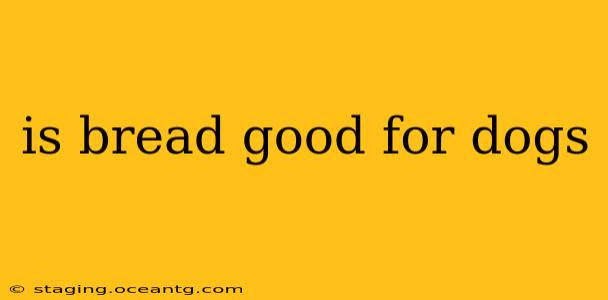Bread, a staple in many human diets, often sparks the question: "Is bread good for dogs?" The short answer is complex—it depends. While a small amount of plain bread won't likely harm a healthy adult dog, it's not ideal and shouldn't be a regular part of their diet. This guide delves into the nutritional aspects, potential dangers, and best practices regarding bread and canine companions.
What are the nutritional benefits of bread for dogs?
Bread offers minimal nutritional value for dogs. It primarily provides carbohydrates, which dogs can process, but they don't need large quantities. A dog's diet should focus on protein and fats for energy and essential nutrients, not carbohydrates sourced from bread. While some bread contains small amounts of vitamins and minerals, these are far from sufficient to meet a dog's nutritional requirements, and can be easily sourced from dog food. Therefore, any benefits are negligible compared to the potential downsides.
Can dogs eat bread? What types of bread are safe?
Yes, dogs can technically eat bread, but that doesn't mean they should. Plain, unsalted, unflavored white bread is the safest option, provided it's given sparingly. Avoid bread containing:
- Raisins or grapes: These are highly toxic to dogs.
- Onions or garlic: These can cause anemia.
- Chocolate: Toxic to dogs, even in small amounts.
- Nuts: Many nuts contain toxins or can cause allergic reactions.
- Xylitol: An artificial sweetener that's extremely toxic to dogs.
- Yeast: While dogs can tolerate small amounts, large quantities of raw yeast dough can rise in their stomach causing discomfort, pain, and potentially bloat.
- Seasonings or spices: These can upset a dog's stomach.
Even plain bread should be considered an occasional treat, not a dietary staple.
What happens if a dog eats bread?
For a healthy adult dog, a small piece of plain bread is unlikely to cause serious problems. However, excessive consumption can lead to:
- Weight gain: Bread is high in carbohydrates and calories, contributing to obesity if given frequently.
- Digestive upset: Bread can cause diarrhea, vomiting, or gas in some dogs, particularly if they have sensitive stomachs.
- Pancreatitis: In some cases, high-fat breads can trigger pancreatitis, a serious inflammation of the pancreas.
Is bread bad for dogs with diabetes?
Yes, bread is generally not recommended for dogs with diabetes. The high carbohydrate content can significantly impact blood sugar levels, making it difficult to manage the condition. Always consult your veterinarian before introducing new foods into a diabetic dog's diet.
My dog ate bread, what should I do?
If your dog ate a small amount of plain bread, you likely don't need to worry. Monitor them for any signs of digestive upset, such as vomiting, diarrhea, or lethargy. If your dog ate a large quantity of bread, especially bread containing harmful ingredients, contact your veterinarian immediately. If you suspect your dog ingested something toxic like xylitol, raisins, or chocolate, immediate veterinary attention is crucial.
What are better alternatives to bread for dogs?
Instead of offering bread, consider healthier alternatives as occasional treats:
- Plain cooked carrots: Good source of fiber.
- Plain cooked green beans: Low in calories and packed with nutrients.
- Small pieces of apple (without seeds or core): Provides vitamins and fiber.
- Dog-specific treats: Formulated to meet your dog's nutritional needs.
Always prioritize your dog's health. Consult your veterinarian before introducing any new food into their diet, especially if they have pre-existing health conditions. A balanced diet tailored to their needs is key to a happy and healthy canine companion.
